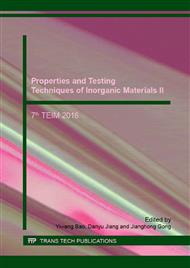p.532
p.537
p.542
p.547
p.553
p.558
p.564
p.569
p.576
Fracture Properties of Ultra-High Strength Cement-Based Materials
Abstract:
By combining the three-point bending beam test with theoretical derivation, the elastic modulus, fracture toughness, surface energy and the maximum defect size permissible under certain working stress of ultra-high strength cement-based materials were obtained. The fracture properties were studied with the water to binder ratios (W/B) from 0.18 to 0.14. Test results showed that the ultra-high strength cement-based materials are quasi-brittle and the net bending strength of specimen decreased substantially when there was a notch. The elastic modulus of ultra-high strength cement-based materials can be up to 74.0 GPa, obviously higher than that of ordinary cement-based materials, showing greater elastic deformation resistance. Moreover, with decrease of W/B ratio, the compressive strength, fracture toughness, critical strain energy release rate as well as the maximum defect size permissible under certain working stress of ultra-high strength cement-based materials increased significantly, indicating that the anti-cracking ability increased with the decrease of W/B ratio.
Info:
Periodical:
Pages:
553-557
Citation:
Online since:
January 2017
Price:
Сopyright:
© 2017 Trans Tech Publications Ltd. All Rights Reserved
Share:
Citation:


